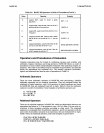
Language Elements
2-10
String Arrays
Like numeric arrays, string arrays can be dimensioned with the DIM statement. The
format for dimensioning a string array
is
the same as for numeric arrays:
DIM A$(5,25,40)
If
you
don't
execute a DIM statement, a default
of
10
for each subscript
is
assumed.
If
this value
is
then exceeded, an error message will result.
Order
1.
2·.
3.
4.
5.
6.
7.
8.
Table
2-6. BASIC-80
Operators
in
Order
of
Precedence
Operator
Expressions in parentheses.
Exponentiation, as shown in the example,
where A is raised to the B power.
Negation, represented by the minus sign.
Multiplication and Division, represented by
an
asterisk
(*)
and a slash
(I)
respectively.
Integer
division,
represented
by
a
backslash (
).
Both arguments are con-
verted to integer
values and the result is
truncated to an integer.
Integer Modulus, represented by MOD.
Both arguments are converted into in-
tegers. The
result is the remainder when
the first is divided by the second.
Addition and Subtraction, represented by
(+) and minus
(-)
signs.
Relational Operators. These are listed
without precedence. For all relational
operators, the result is -1
if
true, and 0 if
false. The arguments A and B must
be
both
strings
or
both numeric variables.
Equals sign: Used to
test
for equality.
Greater Than: Used to test magnitude be-
tween two arguments. The
large end
of
the
sign faces the posited greater
value.
Less Than: Used to test magnitude between
two arguments. The
small end of the
sign faces the posited
less.er value.
Not Equal: Used to test for inequality be-
tween
two
arguments.
Greater Than or
Equal To: Used to test
magnitude down to the
level
of
the second
argument.
Less Than
or
Equal To: Used to test
magnitude up to the
value
of
the second
argument.
Example
(A+B)
AtB
-A
A*B
AlB
A\B
AMODB
A+B
A-B
A=B
A>B
A<B
A><B
A<>B
A=>B
A>=B
A=<B
A<=B
In
the Logical Operators below, the arguments are converted to 16-bit, signed
two's
complement integers
in
the range -32768 to
+32767.
The result of the operation is
converted to the same format. The operations are performed one
bit
at a time, com-
paring the nth bit
of
X with the nth bit of
Y.
BASIC-80


















